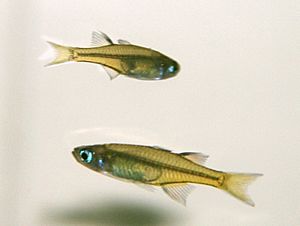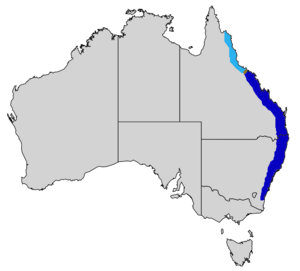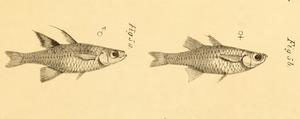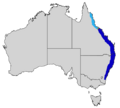Pacific blue-eye facts for kids
Quick facts for kids Pacific blue-eye |
|
|---|---|
 |
|
| Conservation status | |
| Scientific classification | |
 |
|
| subspecies signifer (dark blue) subspecies signata (light blue) |
|
| Synonyms | |
|
Atherina signata Günther, 1867 |
The Pacific blue-eye (Pseudomugil signifer) is a small, shiny fish found in eastern Australia. It was first described by a scientist named Rudolf Kner in 1866. This fish has two main types, called subspecies, that live in different areas. Scientists are still studying if these two types should be considered separate species.
You can find the Pacific blue-eye in rivers and estuaries (where rivers meet the sea) along the eastern coast of Australia. Its range stretches from Cape York in northern Queensland down to southern New South Wales. A natural break in the land, called the Burdekin Gap, separates where the two subspecies live.
This fish is usually about 3.25 cm (about 1.25 inches) long. It's easy to spot because of its bright blue eye-ring and two fins on its back. Pacific blue-eyes often swim together in large groups, from tens to thousands of fish. They eat insects that fall into the water or fly near the surface, finding their food by sight. These fish can also live well in aquariums.
Contents
Discovering the Pacific Blue-Eye
The Pacific blue-eye was first described in 1866 by an Austrian scientist named Rudolf Kner. He studied a fish sample collected in Sydney in 1858. Later, other scientists described similar fish from different parts of Australia, giving them different names.
For a long time, scientists thought there might be two separate species: a northern one and a southern one. However, in 1979, researchers decided that all these fish were just one species because their differences were not big enough. More recently, in 2002 and 2004, new studies looked at the fish's DNA. These studies showed that the northern and southern groups are genetically different. This means they might be reclassified as two separate species again in the future.
What Does the Pacific Blue-Eye Look Like?
The Pacific blue-eye is usually about 3 to 3.5 cm (1.2 to 1.4 inches) long. However, males can grow up to 8.8 cm (3.5 inches), and females up to 6.3 cm (2.5 inches). In the northern part of their range, both males and females are about the same size. But in the south, males are noticeably larger than females.
Their bodies are long and partly see-through, with a pale yellow or olive color. Their bellies and gill covers are silver. They have large scales that are taller than they are wide. Their eyes are big and have a bright blue circle around them.
The fish has two fins on its back (dorsal fins). Its tail fin is forked, with rounded tips and white edges on the top and bottom. Male Pacific blue-eyes have longer, flowing parts on their back, anal, and pelvic fins. During the breeding season, the male's fins can even turn orange! You can tell a Pacific blue-eye apart from the invasive eastern mosquitofish because the blue-eye has a forked tail, while the mosquitofish has a rounded one.
Where Do They Live?
The Pacific blue-eye lives along the eastern coast of Australia. You can find them from Narooma in southern New South Wales all the way north to the Rocky River in Cape York. They prefer small, slow-moving streams and estuaries. They also live in lagoons near sand dunes and in salt marshes.
Sometimes, they are found in salty ocean waters around islands off the coast of Queensland. These fish can even travel far upstream, up to 300 km (185 miles) from the coast, into rivers like the Mary and Dawson Rivers. In some places, like the Mary River, there are huge numbers of Pacific blue-eyes.
In fast-flowing streams, Pacific blue-eyes will find shelter in calmer spots. They often stay in areas where the water moves slower than 20 cm (8 inches) per second. They can also be found in tidal pools that become cut off from rivers when the tide is low. These fish also swim into mangrove forests when the tide comes in, looking for food in the shallow water.
How They Behave
Pacific blue-eyes typically swim in loose groups, or schools, that can have from ten to thousands of fish. They usually stay in the middle or upper part of the water, often close to the riverbank and near places where they can hide, like underwater plants or rocks.
These fish are very adaptable to different water salt levels. They can live in fresh water, brackish water (a mix of fresh and salt), and even full ocean water. When the saltiness of the water changes, they can adjust their swim bladder (a gas-filled organ that helps them float) to control their buoyancy. This amazing ability helps them survive in their changing estuary homes.
If a school of Pacific blue-eyes feels threatened, a few fish will suddenly speed up and change direction. This creates a "wave" of escape that spreads quickly through the whole group. If a single blue-eye is threatened, it will dart around randomly for a few seconds to try and escape.
Reproduction and Life Cycle
Female Pacific blue-eyes can start having babies when they are about six months old. This is usually when they reach about 2.3 cm (0.9 inches) in length. Males become ready to breed when they are about 2.8 cm (1.1 inches) long. Studies show that males often choose larger females because bigger females lay more eggs.
These fish can breed in both fresh and salt water. In the wild, Pacific blue-eyes usually live for about 1 to 2 years. In aquariums, they can live a bit longer, around 2 to 3 years, with some males living up to 4 years. In an aquarium, they lay their eggs in gravel or moss at the bottom of water plants.
Unfortunately, if Pacific blue-eyes are kept with mosquitofish, their growth and breeding can be badly affected. Scientists think this is mainly due to stress from being around the mosquitofish, even if there isn't a lot of direct fighting.
What Do They Eat?
The Pacific blue-eye's diet mainly includes insects that live in the water or flying insects that land on the water's surface, like different types of flies. They also eat small crustaceans and some algae.
They find their food by sight. Studies have shown that Pacific blue-eyes spend time near the water surface, looking for dead flying insects. They will eat anything that fits into their mouth, which is usually insects between 2.5 to 3.5 mm long. The clearness of the water is important for them to be able to see and find their food.
Images for kids





